The photographs on this page appear by
kind permission of
Traditionsverband.de and
originally appeared on the
Traditionsverband Forum. They show the collection as it was originally displayed
in the style of a museum by Mr Siebentritt. Please respect the
copyright owner's generosity in sharing them with us by
not reproducing them without prior permission. A section of the display
showing items mainly from South West Africa
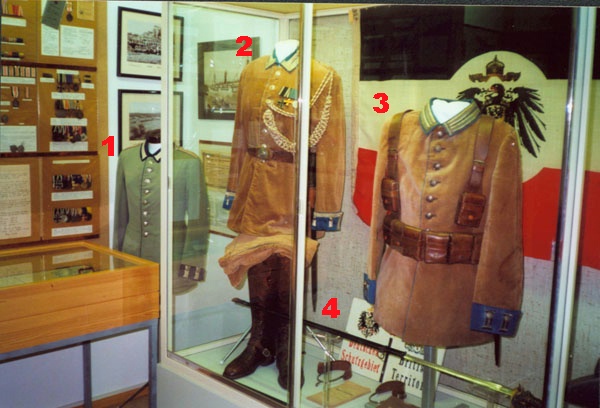
1 - South West African
Schutztruppe Other Ranks 1896 Grey Home Uniform Tunic
Note the
blue collar, cuffs and piping for South West Africa. Also note the
other ranks white Litzen on the collar and Swedish style cuffs. On the
left shoulder can be made out an other ranks white, red and black
twisted cord shoulder strap.
2- South West African
Schutztruppe NCOs 1896 Corduroy Uniform Tunic
Note again the
blue collar, cuffs and piping for South West Africa and the other
ranks white Litzen on the collar and Swedish style cuffs. Note also
the NCO lace on the collar and cuffs, parade cords from the left
shoulder and medal display, with what looks like an Iron Cross showing
these medals were probably received after the First World War.
3- South West African
Schutztruppe Officers 1896 Corduroy Uniform Tunic
Judging from the size
of the collar Litzen and their shade (appearing to be silver), this
is probably an officers tunic. Aside from these details, the uniform is
basically the same as the previous other ranks tunic. The shoulder
straps showing the wearer's rank
are missing. Note the other ranks mounted equipment being worn.
4 - Miscellaneous Items
of Interest
Also in the display case
are a pair of Schutztruppe officers riding boots, a border
sign between German and British territory in Africa, an officers sword
and a pair of stirrups. Behind the officers tunic is a
large imperial flag as commonly flown in the colonies.
Another section of the display
showing items mainly from South West Africa
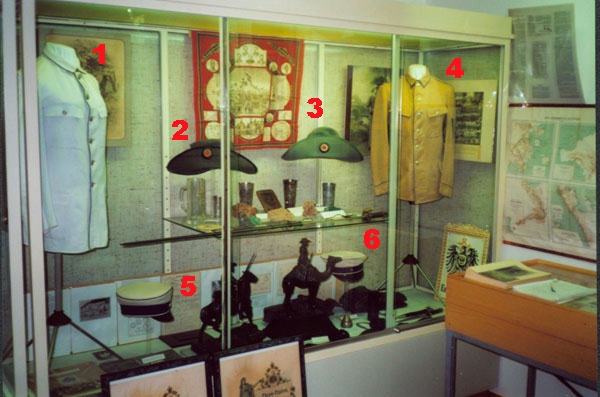
1- South West African
Schutztruppe NCO or Officers 1896 White Tropical Uniform Tunic
Note the blue Schutztruppe piping on the collar and front. This
tunic has several variations on the authorised version due to private
tailoring- no cuff piping, unpleated pockets and an absence of
shoulder straps, although these may have been removed since it was
last worn.
2- South West African
Schutztruppe Südwester Hat
Note the large imperial cockade and blue edging for South West
Africa.
3-
Another South West African
Schutztruppe Südwester Hat
Note the hat appears to be of a much darker shade, this may be
partially due to the lighting in the display but also differences in
manufacture, especially amongst privately purchased items made
variations in shade common in uniforms.
4- South West African
Schutztruppe NCOs 1896 Khaki Uniform Tunic
Note the blue Schutztruppe piping on the collar, cuffs and front
as well as the NCO rank chevrons just visible on the left arm. Another
photograph of this same tunic in "Imperial German Field Uniforms and
Equipment 1907-18 Vol3" by Johan Somers, shows the tunic had three
chevrons, thus the original owner's rank was a Vize-Feldwebel.
5 & 6- A pair of South West African
Schutztruppe Peaked Field Caps
Note the blue hatbands and piping for
South West Africa.
A section of the display
showing items mainly from East Africa
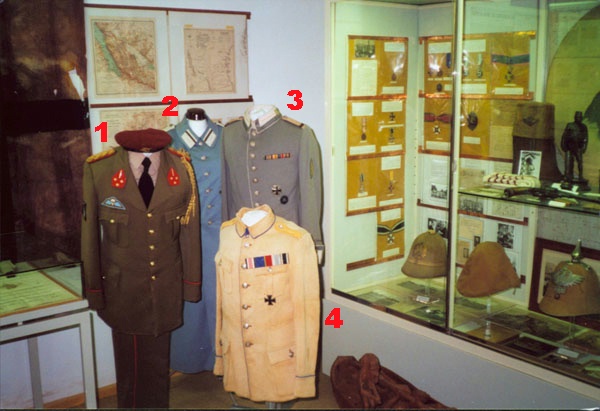
1-
An Unrelated Uniform
It looks to me to be the
uniform of a Belgian Paratroop
officer from the 1970s, though I may be wrong here.
2- East African
Schutztruppe NCOs Greatcoat
Note the white collar
patches and shoulder straps for East Africa. The white Litzen on the
collar cannot be made out against the similarly white collar patches
but the NCOs rank bar is clearly visible.
3-
East African
Schutztruppe NCOs 1896 Grey Home Uniform Tunic
Note the white
collar and cuffs for East Africa with Litzen and rank lace. Just visible on the left cuff are two bars of lace showing the
original owner to
have been a Feldwebel. Note also that a badge can be seen on the upper
left arm, although it cannot be made out here, another photograph of
this same tunic in "Imperial German Field Uniforms and Equipment
1907-18 Vol3" by Johan Somers, shows it to be a grey oval medics badge
with a yellow metallic Rod of Asclepius. The medals on the left breast include an Iron
Cross and a First World War wound badge, showing this uniform was
probably worn after 1918.
4- Schutztruppe
Veterans Tunic
Veterans of the German colonies often had new uniforms privately
made after 1918 for wearing on official occasions or as part of
veterans organisations. These uniforms were often of exactly the same
cut (sometimes by the same tailors who worked on them before 1914) and
thus can be very confusing for collectors of militaria. Often however
differences in cut or detail were allowed as no uniform regulations
now had to be adhered to. This tunic is made the the same cut as a
Schutztruppe 1896 khaki tunic with the same blue piping on the collar,
cuffs and front, but is made of a different cord-style cloth often
worn by veterans units. The shoulder straps are yellow, which again
was not Schutztruppe standard but may indicate different veterans
units and again the medals, including the Iron Cross show that this
uniform was worn after 1918.
Another section of the display
showing items mainly from East Africa
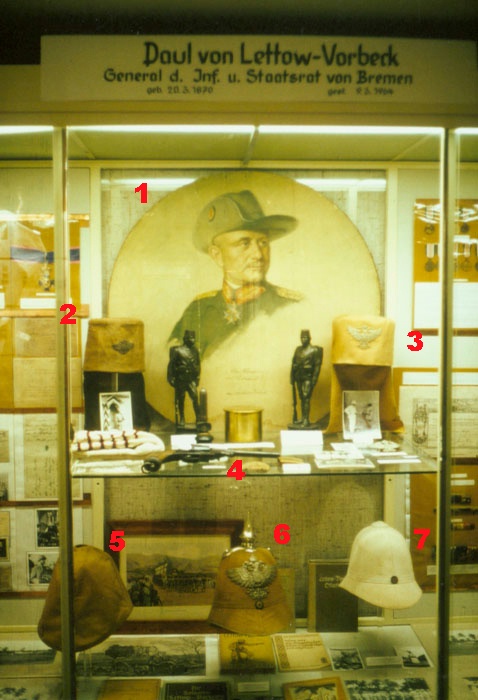
1- Portrait of General
Paul von Lettow-Vorbeck
Note the field grey uniform worn with his Pour-le-Mérite medal
worn at the throat and general's red collar patches all show this to
have been a post 1918 picture. He still proudly wears his Schutztruppe
Südwester though.
2- East African
Schutztruppe Askari Tarbush
Note the white metal imperial eagle on the front.
3- East African
Schutztruppe Askari Tarbush
Note that this one has a noticeably larger imperial eagle. I have
never seen any photos showing askaris of the period with larger white metal eagles
(Effendi officers wore larger "gold" eagles and the Polizeitruppe wore
larger yellow metal eagles). It maybe that this tarbush was made after
1918 for an askari veteran, such as the film actor, Muhammed
Hussein.
4- 1879 Army Revolver
This pistol was commonly issued in the colonies in the late 19th
century.
5- Tropical Helmet with
a Khaki Cover
These covers were commonly worn by the
Schutztruppe, Polizeitruppe, Seebatallione and navy to cover white
helmets on active service. Note the large hole visible at the top. A
common method of fixing the covers in place was to unscrew the top
ventilation cover and replace it over the cover, thus leaving a white
top to the helmet.
6- South West African
Schutztruppe 1892 Tropical Helmet
Note the Pickelhaube style spike on a
cruciform base and large imperial eagle above an imperial cockade.
These helmets were short lived and were not used after 1896.
7- White Tropical
Helmet
This style of white helmet with an
imperial cockade was widely used by the Schutztruppe and Polizeitruppe
in all colonies except South West Africa.
A section of the display
showing items mainly from Cameroon and Togo
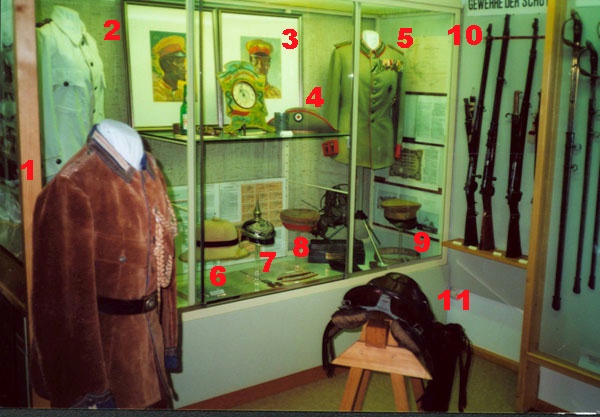
1-
South West African Schutztruppe NCOs 1894 Corduroy Uniform Tunic
Note the pointed Polish style cuffs and breast pockets discarded
on later corduroy tunics. Also note the parade cords from the left
shoulder and the NCO lace on the collar and cuffs.
2- Togo
Officers White Tropical Uniform Tunic
In the left background
in the display case is a white tropical tunic. Although the tunic
cannot be seen clearly in this photograph, the same tunic has more
recently been photographed in Johan Somers' "Imperial German Uniforms
and Equipment 1907-18 Vol3". The photographs in the book show it to be
a unique piece of uniform as it appears to be the tunic of
a regular imperial army officer worn while on secondment to Togo
sometime between 1912 and 1914. It has the shoulder straps of a
Leutnant of the 99th Upper Rhineland Infantry Regt ("2.
Oberrheinisches Infanterie-Regt. Nr.99") of the regular imperial
army but is piped in Togo yellow (introduced in 1912) around the
collar, cuffs, and front. Curiously the cuffs are also buttoned in the
Swedish style.
3- Two Portraits of
Togo Polizeitruppe Soldiers
Note red collar bars and that they are both wearing the khaki field cap
(with red hatband) introduced in 1910.
4- Cameroon
Schutztruppe Südwester Hat
Note the large imperial cockade and red edging for Cameroon. This
hat may well belong with the tunic next to it.
5- Cameroon
Schutztruppe Officers 1896 Grey Home Uniform Tunic
Note the red collar, cuffs and
shoulder strap underlay for Cameroon. At least some of the medals are
post-1918 awards (such as the Iron Cross second class in the
buttonhole). A closer photo of this tunic in Johan Somers' "Imperial
German Uniforms and Equipment 1907-18 Vol3" shows the shoulder straps
to indicate the wearer was a Leutnant, though this photo is without
the medal bar.
6-
Tropical Helmet
A tropical helmet with a black hatband edged in red. This may belonged
to a colonial official such as a Gunsmith or Veterinarian (both of
whom wore such hatbands on their field caps, though not usually on
their tropical helmets).
7-
Schutztruppe Officers Pickelhaube
A Schutztruppe
Pickelhaube with an imperial eagle with spread wings on the front. The
Pickelhaube was rarely worn by the Schutztruppe. It was authorised for
use by the East African Schutztruppe for use with their blue home
uniform in 1891, but replaced in 1896 with the Südwester hat. In 1916
new orders authorised a Pickelhaube for all Schutztruppe with the new
field grey home uniform. The 1916 order had little effect beyond the
officers of the Colonial Office in Berlin, as the majority of the
Schutztruppe by this date were either in enemy prisoner of war camps
or blockaded in East Africa. This particular example has an officers
long spike.
8-
Cameroon Peaked Cap
Note the red hatband and piping for Cameroon.
9-
Khaki Peaked Cap
A khaki peaked cap of unknown origin.
10- A Collection of
Schutztruppe Rifles and Bayonets
Unfortunately they cannot be positively identified from this
photograph.
11 - Schutztruppe Horse Saddle
A section of the display
showing a selection of Schutztruppe swords
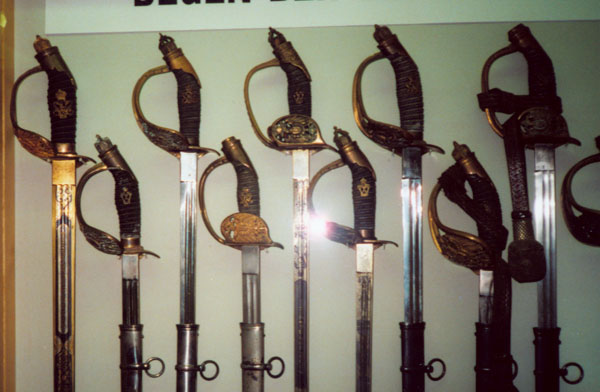
Unfortunately it is
difficult to positively identify all the swords from this photograph
(see also the
Swords Details Page
on this website).
A section of the display
mostly showing maps and
photographs from the colonies
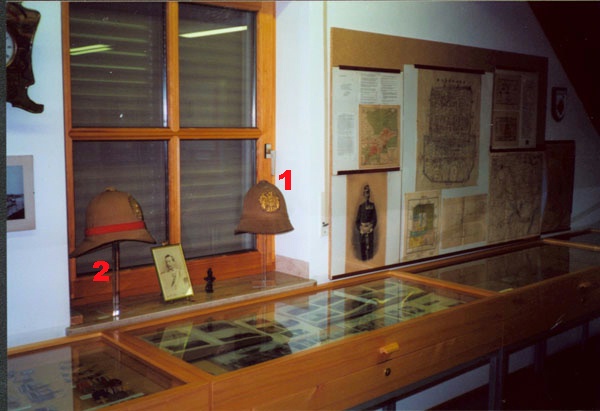
1 & 2- East
Asian Tropical Helmets
On the window sill are two Bortfeldt khaki tropical
helmets from the German East Asian Expeditionary Corps/Occupation
Brigade (c1900-04). They both have a brass imperial eagle on the front with the
one on the left also displaying a red hatband showing it to have been
worn by the East Asian Cavalry.
A section of the display
showing framed photographs and commemorative boards
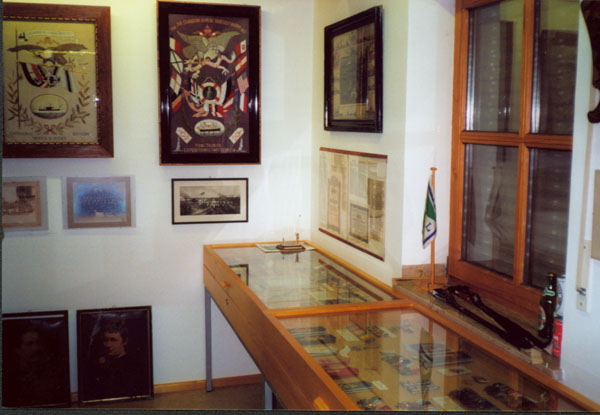
On the
wall are a pair of framed commemoration boards. This were usually
made to commemorate service in the armed forces. Both appear to be
naval in original judging from the fact that each carries an imperial
flag and a photograph of a ship in the centre. The board on the right
also has the flags of the eight nation alliance which defeated the
Boxer Rebellion in China 1900-01, thus implying the owner served
either in the rebellion or the allied occupation of parts of China
following its defeat.
A section of the display
showing two tunics and maps of the colonies
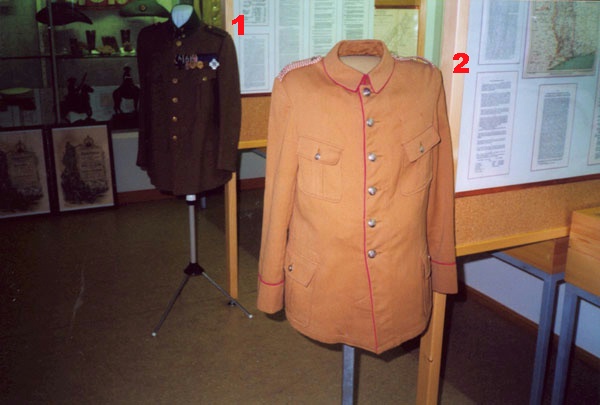
1- South West African
Landespolizei NCOs 1907 Uniform Tunic
This 1907 tunic may
well have been made after 1918 for a veteran of the Landespolizei to
wear on parade and at official functions. Certainly the medals worn on
the left breast include awards received after 1918. Closer examination
of the tunic (in photographs published in Johan Somers' "Imperial
German Uniforms and Equipment 1907-18 Vol3") shows it to confusingly
have the collar insignia of a Wachtmeister (two pips) and the shoulder
strap insignia of a Diensttuender
Polizeiwachtmeister or Berittführer (thick yellow metallic lace
around a green strap).
2- Cameroon
Schutztruppe NCO Veterans Tunic
This tunic was made
for a veteran of the Schutztruppe who served in Cameroon. It has the
same shoulder straps and general cut as an 1896 other ranks
Schutztruppe khaki tunic, but whereas before and during the First
World War such tunics had blue piping for the Schutztruppe of all
colonies, this tunic has Cameroon's red piping and also a "Peter's
Flag" badge on the left lower sleeve (out of sight in this
photograph), showing it to be a veterans tunic. The Peter's Flag was a
shield shaped badge based on the flag of the German East African
Company (a white background divided by a black cross, the upper left
corner being red with five white stars. Post 1933 versions had a
swastika on a diamond shaped background in the centre) and was the
symbol of the German Colonial Association ("Deutsche
Kolonialgesellschaft" or "Reichskolonialbund" after 1936).
A section of the display
showing documents mainly from East Africa
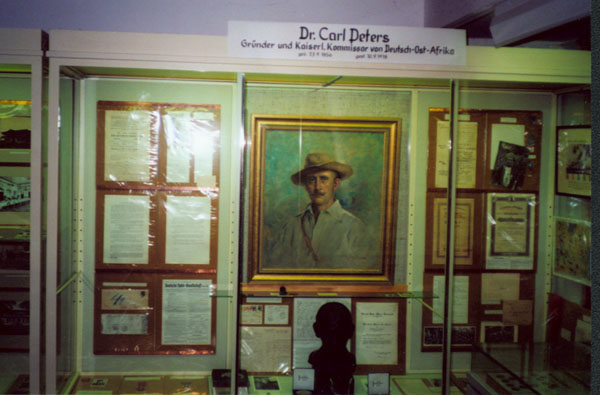
Note in the centre, the large portrait of
Dr Carl
Peters, the founder and Imperial Commissioner of German East Africa.
|